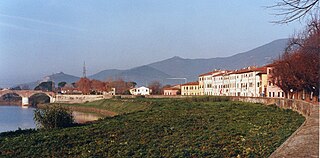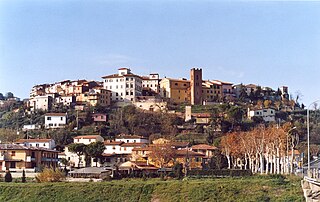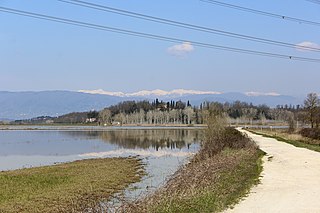
Lucca is a city and comune in Tuscany, Central Italy, on the Serchio River, in a fertile plain near the Ligurian Sea. The city has a population of about 89,000, while its province has a population of 383,957.

The province of Lucca is a province in the Tuscany region of Italy. Its capital is the city of Lucca.

The Monti Cimini, in English: Cimini Hills, are a range of densely wooded volcanic hills approximately 56 km (35 mi) north-west of Rome. They are part of the Antiapennine range, facing the Apennines main range towards the Tyrrhenian Sea. They are situated in the centre of Tuscia Viterbese, the highest point at Mount Cimino, 1,053 m (3,455 ft) above sea level. Lake Vico, a volcanic crater lake, is situated in the hills.

The Duchy of Lucca was a small Italian state existing from 1815 to 1847. It was centered on the city of Lucca.

Viareggio is a city and comune in northern Tuscany, Italy, on the coast of the Tyrrhenian Sea. With a population of over 62,000, it is the second largest city in the province of Lucca, after Lucca.

Central Italy is one of the five official statistical regions of Italy used by the National Institute of Statistics (ISTAT), a first-level NUTS region, and a European Parliament constituency.

Bagni di Lucca is a comune of Tuscany, Italy, in the Province of Lucca with a population of about 6,100. The comune has 27 named frazioni (wards).

Camaiore is a city and comune of 32,513 inhabitants within the province of Lucca, Tuscany, central-western Italy. It stretches from the Apuan Alps to the east, to the plains and the coast of Versilia to the west.

Vico del Gargano is a village and comune in the province of Foggia in the Apulia region of southeast Italy. Called the "Village of Love", it is part of the Gargano National Park and the Mountain Community of Gargano.

Calcinaia is a comune (municipality) and town in the province of Pisa in the Italian region Tuscany, located about 50 kilometres (31 mi) west of Florence and about 20 kilometres (12 mi) east of Pisa.

Santa Maria a Monte is a comune in the Province of Pisa in the Italian region of Tuscany. The town lies about 45 kilometres west of Florence and about 25 kilometres (16 mi) east of Pisa.

The March of Tuscany was a march of the Kingdom of Italy and the Holy Roman Empire during the Middle Ages. Located in northwestern central Italy, it bordered the Papal States to the south, the Ligurian Sea to the west and Lombardy to the north. It comprised a collection of counties, largely in the valley of the River Arno, originally centered on Lucca.

The Arbia is a torrent in Tuscany, central Italy, a tributary of the river Ombrone. Its source is located in the comune of Castellina in Chianti, at 620 m above sea level. It flows into the Ombrone near Buonconvento.

Lago di Bientina, also known as Lago di Sesto, was a lake in Tuscany, Italy. Located to the north of the town of Bientina, between Lucca and Pisa, the lake was historically subject to numerous efforts at drainage due to its tendency to flood. Early attempts at canal-building and drainage in the 16th century were hampered by the lake's connection with the Arno River, which often led to backflow and even increased flooding.

The Principality of Lucca and Piombino was created in July 1805 by Napoleon I for his sister Elisa Bonaparte. It was a state located on the central Italian Peninsula and was a client state of Napoleonic France.

Paganico is a village in the province of Grosseto, in southern Tuscany, central Italy. It is a frazione of the comune of Civitella Paganico. It lies in the valley of the Ombrone river, at 66 meters above the sea level. In 2011 it had a population of 961 inhabitants.

Verrucole Castle is a medieval fortress located in the Garfagnana region of Tuscany, Italy, in San Romano in Garfagnana comune, near the city of Lucca. It is 600 metres (2,000 ft) above sea level.

Lugliano is a small frazione (village) located in the municipality of Bagni di Lucca, in the Province of Lucca, Tuscany.

The flag of Tuscany is the official flag of the region of Tuscany, Italy. The flag depicts a silver Pegasus rampant on a white field between two horizontal red bands. The flag first appeared as a gonfalon on 20 May 1975 along with accompanying text Regione Toscana above the Pegasus. It was officially adopted as the flag of Tuscany on 3 February 1995.
MountContrario is a mountain belonging to the Apuan Alps chain, that lies 1,789 m (5,869 ft) above sea level. It is located in upper Tuscany, Italy, between the provinces of Lucca and Massa-Carrara; it is part of the Apuan Alps Regional Park.




















